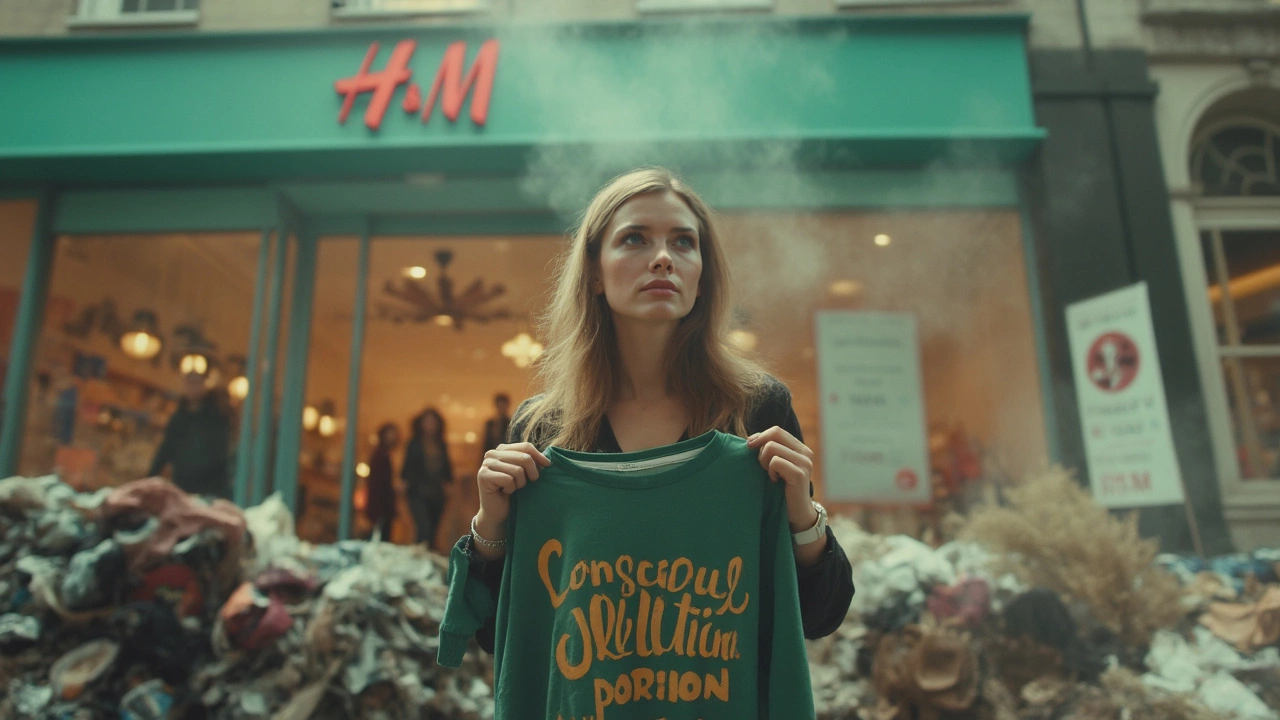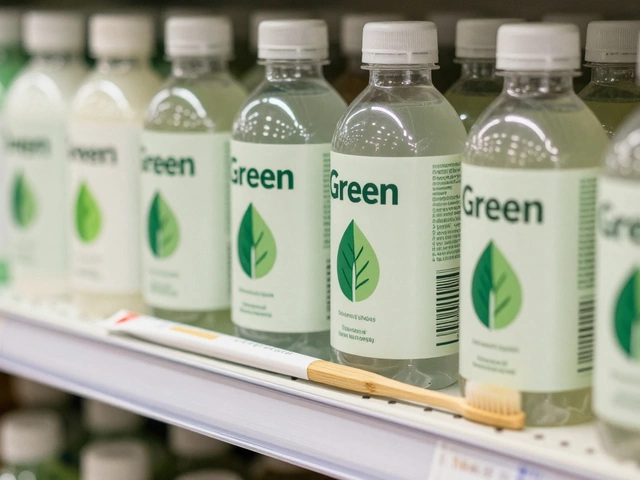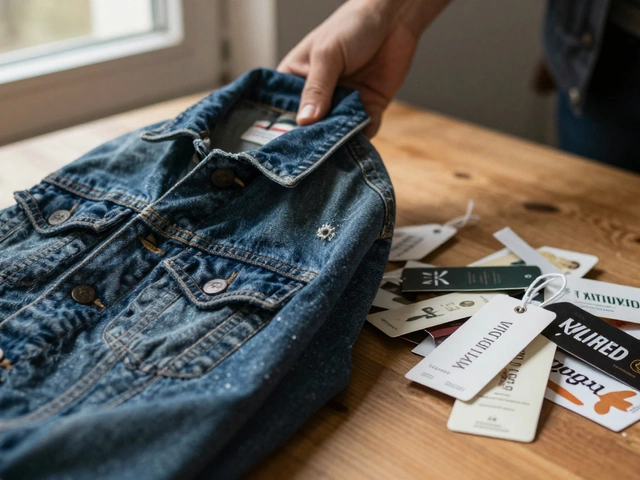H&M loves to show off its green side, but when you look closer, things don't add up. Their stores are packed with trendy clothes you want right now, at dirt-cheap prices. But behind every low price tag is a much bigger cost for the planet. Does tossing out massive ‘Conscious Collection’ ads really help, or is it just a band-aid for a much deeper problem?
If you care about where your clothes come from, you need to know the full story. Fast fashion isn’t just about new looks every week—it’s about using up massive resources, filling up landfills, and polluting waterways, all for the sake of ‘keeping up.’ H&M’s eco claims sound good, but digging into the process shows a pile-up of hidden waste, unclear sourcing, and some marketing tricks that leave shoppers confused.
Wondering if you’re being fooled by green labels? You’re not alone. Let’s get smart about the facts, and talk real tips for finding brands (and habits) that actually make a difference.
- The Fast Fashion Problem
- H&M’s ‘Conscious’ Collection—What’s Really Behind It?
- Greenwashing: The Marketing vs. Reality
- Better Ways to Shop Eco-Friendly
The Fast Fashion Problem
You’ve probably wondered why clothes at H&M are so cheap and how they keep the racks so full. It all boils down to fast fashion. This business model pumps out trendy products at breakneck speed, and that means a pile-up of hidden costs for both workers and the environment. According to the Ellen MacArthur Foundation, "the equivalent of one garbage truck of textiles is landfilled or burned every second." Let that sink in: every single second.
H&M is one of the biggest names in fast fashion, selling billions of items every year. They launch new collections every few weeks—sometimes even in the same month. All those t-shirts, jeans, and dresses may look cute on hangers, but making that much stuff quickly and cheaply is a problem.
Here’s a look at just how big the issues are:
| Problem | Fact/Stat |
|---|---|
| Water use | One cotton t-shirt takes about 2,700 liters of water to make (enough for one person to drink for 2.5 years). |
| Waste | More than 85% of all textiles end up in landfills yearly, including those from fast fashion chains. |
| Carbon footprint | The fashion industry is responsible for about 10% of global CO2 emissions—more than international flights and shipping combined. |
Big brands like H&M don’t just use massive amounts of resources; they encourage us to keep buying more. When a t-shirt costs less than a sandwich, it’s tempting to just ‘grab another’ every shopping trip. This cycle keeps textile waste growing. The H&M strategy looks efficient, but it actually drives overconsumption as a core goal.
Spotting the fast fashion signs is easy if you know what to look for:
- Ultra-low prices
- New items every week
- Trendy designs that go out of style fast
- Materials that wear out quickly
If your closet looks like a revolving door and half of it still has tags, that’s fast fashion in action. All this speed, low cost, and turnover ends up costing way more when you count the true impact on the planet.
H&M’s ‘Conscious’ Collection—What’s Really Behind It?
H&M’s 'Conscious' Collection is supposed to be the brand’s answer to eco-guilt. Strolling past the green tags, you’ll see promises about organic cotton, recycled polyester, and reduced impact. Sounds awesome, right? But let’s break down what’s really going on behind those labels.
The main issue: only a tiny slice of H&M’s whole lineup actually uses these “better” materials. According to H&M, just about 18% of their total materials in 2024 were from recycled or more sustainable sources. That means over 80% of their stuff isn’t as green as you might believe. The rest is the same old fast fashion—just dressed up in a few recycled threads.
Not all eco-materials are the same, either. For example, their so-called “organic” cotton often blends with regular cotton, and “recycled” polyester can mean just a small fraction of the fabric. H&M doesn’t always say where or how the recycled materials are sourced. Plus, even their recycled fabrics shed microplastics and use tons of energy to make. It’s a numbers game—you get the benefits on a tag, but the actual change is often too small to matter on a big scale.
Let’s check out how the H&M Conscious Collection really stacks up with their entire clothing lineup:
| H&M Category | % Using ‘Conscious’ Materials (2024) | Regular (Non-Conscious) Materials % |
|---|---|---|
| Women's Clothing | 21% | 79% |
| Men's Clothing | 16% | 84% |
| Kids' Clothing | 10% | 90% |
Then there’s the problem of quantity. H&M still churns out around three billion pieces of clothing every year. It doesn’t matter how ‘green’ one shirt is if there are mountains of waste from disposable styles. No company can really call itself eco-friendly if it keeps pushing people to buy more and more.
- If you see a 'Conscious' label, check the actual materials on the tag—what percentage is really recycled or organic?
- Remember: one greener shirt in a pile of ordinary clothes doesn’t change the impact of non-stop production.
- Don’t get fooled by marketing—ask yourself, is the company making real changes, or just making the ads look good?
The truth? H&M’s ‘eco’ efforts are a start, not a solution. If you want to shop smarter, don’t trust buzzwords. Look for real percentages, clear sourcing, and a reason behind their so-called conscious choices.

Greenwashing: The Marketing vs. Reality
Let’s talk about greenwashing—when brands make themselves look way more eco-friendly than they really are. H&M has become a poster child for this trick. Their ads push pictures of happy people in ‘Conscious’ shirts and promise clothes made from recycled stuff. But how much of that is true, and how much is just for show?
Here’s a solid example: H&M’s ‘Conscious’ label. You see it on racks everywhere, suggesting these pieces are sustainable. But dig into the details, and you find out that only a small chunk of those clothes actually use recycled or organic materials. And even then, the amount can be as little as 20%, with the rest being regular polyester or cotton. That’s like sprinkling a bit of spinach on a pizza and calling it a salad.
The company also talks about recycling your old clothes through their in-store collection bins. It sounds awesome—bring in last year’s jeans and give them a second life. But reports have shown that most of the clothes collected aren’t turned into new fashion. Instead, they often get shipped overseas, sold in other markets, or even tossed in the trash if they’re too worn out. Only about 1% of all clothes collected globally end up getting turned back into new fabrics, so that ‘closed loop’ H&M likes to promote is barely working.
There’s more: H&M joined watchdog groups and published long reports about their sustainability goals. But when you check what they’ve actually achieved, the numbers don’t really back up their promises. In 2022, a Norwegian watchdog group called out H&M for false advertising about their eco claims. The company had to change its marketing after being challenged about their so-called ‘environmentally friendly’ products.
- Look for hard details—labels should tell you exactly how much recycled material is in the item.
- Be wary of vague words like ‘conscious,’ ‘eco-smart,’ and ‘sustainable’ with no specifics to back them up.
- Check if the brand shares clear, easy-to-understand reports about their progress—not just fancy promises.
Don’t let the shine of H&M’s green marketing fool you. Knowing what to look out for helps you make smarter choices—and rewards brands that actually walk their talk.
Better Ways to Shop Eco-Friendly
If you’re tired of brands like H&M making bold eco claims while their actions say otherwise, you’re not alone. Shopping truly eco-friendly takes a bit more effort, but the payoff for your wallet and the planet is huge. Here’s how you can make smarter fashion choices without getting duped by greenwashing.
- Check materials: Go for clothes made from genuine organic cotton, TENCEL™, and certified recycled materials. Third-party labels like GOTS (Global Organic Textile Standard) or OEKO-TEX really matter here—don’t just trust words like "conscious" or "natural."
- Buy less, buy better: The most sustainable option is simply to reduce what you buy. Pick staples that last and skip impulse buys. Studies show the average item from a fast fashion brand gets worn only seven times before being tossed.
- Secondhand before new: Thrifting is cool again, and apps like Depop, Vinted, or local thrift stores are packed with finds. Shopping used saves resources and keeps clothing out of landfills.
- Support true sustainable brands: A few smaller labels are completely transparent about wages, materials, and production. Brands like Patagonia, People Tree, and Reformation lay out their supply chains and minimize waste. They aren’t perfect, but their receipts tell a better story than a typical fast fashion tag.
- Wash and care better: Taking good care of your clothes is another green move. Wash cold, line dry, and skip the dryer to save energy and make your gear last longer.
| Fact | Number |
|---|---|
| Global clothing waste sent to landfill each year | Over 92 million tons |
| Water used to make one cotton T-shirt | 2,700 liters |
| Clothing worn before being discarded (Fast Fashion Average) | 7 times |
| Percentage of global CO2 emissions from fashion industry | 8-10% |
Finally, stay skeptical of ‘eco’ collections from massive brands. If a company produces billions of items every year, a few green-looking pieces won’t undo the damage. Next time you see the H&M label claiming to be eco-friendly, look a little closer and put your money behind real change. Small swaps, smarter decisions, and some healthy doubt make a real impact.










